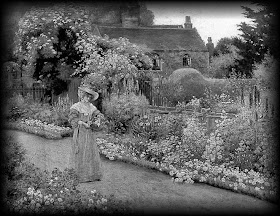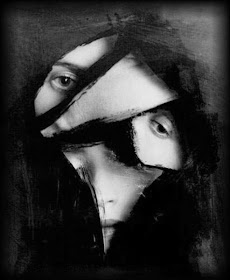Doppelgangers
"The existence of so-called Doppelgangers and spirit doubles is an ancient and widespread belief. According to legend, Doppelgangers (German for "double-walker") is a duplicate of a real person."
It is someone that looks the exact same as another person, yet is not a twin.
Mystics throughout the ages have believed Doppelgangers and spirit doubles are supernatural creatures.
They are either spiritual copies of the person or downright demonic twins."
"Doppelganger" - a shadow self that is thought to accompany every person. Traditionally, it is said that only the owner of the doppelganger can see this phantom self, and that it can be a harbinger of death.
Occasionally, however, a doppelganger can be seen by a person's friends or family, resulting in quite a bit of confusion.
In instances of bi-location, a person can either spontaneously or willingly project his or her double, known as a "wraith," to a remote location. This double is indistinguishable from the real person and can interact with others just as the real person would.
Ghostly doubles and look-alikes have been woven into the fabric of folklore from the Ancient Egyptians to Norse mythology, but modern occurrences and the tale’s perfect suitability to campfire storytelling have made it one of the scariest urban legends.
The sight of your own doppelgänger is said to be an omen of death, while a doppelgänger seen by a person’s friends or family is considered a sinister warning of impending doom.
DO YOU HAVE an exact double somewhere in the world? Can a person be in two places at once? There are many intriguing accounts throughout history of people who claim to have either encountered apparitions of themselves -- their doppelgangers -- or have experienced the phenomenon of bilocation, being in two separate locations at the very same time.
EMILIE SAGÉE
One of the most fascinating reports of a doppelganger comes from American writer Robert Dale Owen who was told the story by Julie von Güldenstubbe, the second daughter of the Baron von Güldenstubbe.
In 1845, when von Güldenstubbe was 13, she attended Pensionat von Neuwelcke, an exclusive girl's school near Wolmar in what is now Latvia.
One of her teachers was a 32-year-old French woman named Emilie Sagée. Although the school's administration was quite pleased with Sagée's performance, she soon became the object of rumor and odd speculation. Sagée, it seemed, had a double that would appear and disappear in full view of the students.
In the middle of class one day, while Sagée was writing on the blackboard, her exact double appeared beside her. The doppelganger precisely copied the teacher's every move as she wrote, except that it did not hold any chalk. The event was witnessed by 13 students in the classroom. A similar incident was reported at dinner one evening when Sagée's doppelganger was seen standing behind her, mimicking the movements of her eating, although it held no utensils.
The doppelganger did not always echo her movements, however. On several occasions, Sagée would be seen in one part of the school when it was known that she was in another at that time.
The most astonishing instance of this took place in full view of the entire student body of 42 students on a summer day in 1846. The girls were all assembled in the school hall for their sewing and embroidery lessons.
As they sat at the long tables working, they could clearly see Sagée in the school's garden gathering flowers.
Another teacher was supervising the children. When this teacher left the room to talk to the headmistress, Sagée's doppelganger appeared in her chair -- while the real Sagée could still be seen in the garden.
The students noted that Sagée's movements in the garden looked tired while the doppelganger sat motionless.
Two brave girls approached the phantom and tried to touch it, but felt an odd resistance in the air surrounding it.
One girl actually stepped between the teacher's chair and the table, passing right through the apparition, which remained motionless. It then slowly vanished.
Sagée claimed never to have seen the doppelganger herself, but said that whenever it was said to appear, she felt drained and fatigued. Her physical color even seemed to pale at those times.
FAMOUS DOPPLEGANGERS
Guy de Maupassant, the French novelist and short story writer, claimed to have been haunted by his doppelganger near the end of his life.
On one occasion, he said, this double entered his room, took a seat opposite him and began to dictate what de Maupassant was writing. He wrote about this experience in his short story "Lui."
John Donne, the 16th century English poet whose work often touched on the metaphysical, was visited by a doppelganger while he was in Paris - not his, but his wife's.
She appeared to him holding a newborn baby. Donne's wife was pregnant at the time, but the apparition was a portent of great sadness.
At the same moment that the doppelganger appeared, his wife had given birth to a stillborn child.
Percy Bysshe Shelley, still considered one of the greatest poets of the English language, encountered his doppelganger in Italy.
The phantom silently pointed toward the Mediterranean Sea.
Not long after, and shortly before his 30th birthday in 1822, Shelley died in a sailing accident - drowned in the Mediterranean Sea.
Queen Elizabeth I of England was shocked to see her doppelganger laid out on her bed. The queen died shortly thereafter. Her doppelganger was described as being "pallid, shivered and wan."
In a case that suggests that doppelgangers might have something to do with time or dimensional shifts, Johann Wolfgang von Goethe, the 18th century German poet, confronted his doppelganger while riding on the road to Drusenheim.
Riding toward him was his exact double, but wearing a gray suit trimmed in gold. Eight years later, von Goethe was again traveling on the same road, but in the opposite direction.
He then realized he was wearing the very gray suit trimmed in gold that he had seen on his double eight years earlier,
Horror is recognizing that when you see yourself from an external position, the realization is that that tragic person whom he or she has been observing, is themselves.
"A man stands here too, staring up into space
And wrings his hands with the strength of his pain
It chills me, when I behold his pale face
For the moon shows me my own features again!"
~ Heinrich Heine
RELATED:
Fear of self: An irrational fear of oneself, an intense self-fear that is groundless. Fear of oneself is termed "autophobia" which comes from two Greek words: "autos" (self) and "phobos" (fear) = literally, self-fear, fear of oneself. Autophobia is the fear of yourself.
Fear of Twins: The official scientific word for the fear of identical twins is duomaieusiophobia. The prefix "duo" means "two" or "double" and the suffix "maieusiophobia" means "fear of childbirth."
Duophobia is the fear of things that come in twos.
Idiaphobia is the fear of things being identical.
Joining the above would make Duoidiaphobia would then mean the fear of two things being the same,
Anthrophobia is the fear of anything human, so although there is no word for a fear of twins you would adjoin the two to make:
Duoidioanthrophobia which would mean two identical humans.
Fear of self: An irrational fear of oneself, an intense self-fear that is groundless. Fear of oneself is termed "autophobia" which comes from two Greek words: "autos" (self) and "phobos" (fear) = literally, self-fear, fear of oneself. Autophobia is the fear of yourself.
Fear of Twins: The official scientific word for the fear of identical twins is duomaieusiophobia. The prefix "duo" means "two" or "double" and the suffix "maieusiophobia" means "fear of childbirth."
Duophobia is the fear of things that come in twos.
Idiaphobia is the fear of things being identical.
Joining the above would make Duoidiaphobia would then mean the fear of two things being the same,
Anthrophobia is the fear of anything human, so although there is no word for a fear of twins you would adjoin the two to make:
Duoidioanthrophobia which would mean two identical humans.

































This comment has been removed by a blog administrator.
ReplyDelete